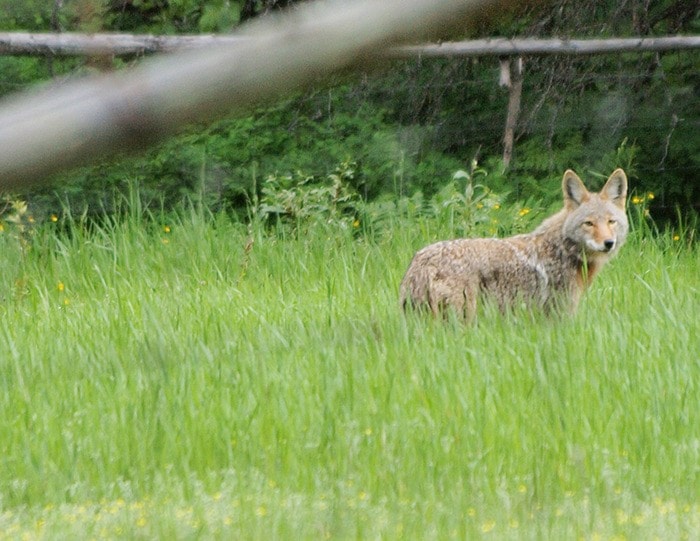An eerie coyote call at dusk may raise the hairs on the back of your neck, but for pets it can prove more dangerous.
Coyotes are skillful predators that can prey on pets warns WildSafeBC community coordinator Joanne Siderius.
“Tempting dogs into the bush to kill and eat them is a common coyote practice — as is stalking and chasing down cats,” she says.
Siderius says coyotes use their call to get dogs interested and then capitalize on a canine’s sense of curiosity and chase instincts.
“Then, there’re other coyotes around and they surround and attack the dog,” she says.
She remembers while living in Creston having to grab up her dog and hold it secure in her arms.
“Right close by where we were walking, a coyote started calling. It was doing a bit of yelping but — the only way I can describe it is wheedling, kind of whining beside us to get the puppy curious,” she says.
Sometimes a dog will just engage in the chase and the coyotes will tire and take off, but sometimes consequences are dire for the pet.
Conservation officers have received at least three reports of coyotes within Nelson’s city limits and Siderius explained their diet consists of more than just rodents.
Domesticated animals aren’t always easy prey for coyotes, large dogs have a better chance with the wild animals. But it’s the smaller dogs that are more susceptible. Siderius suggests keeping pets in at night and watching tethered animals closely. Avoid tethering them near the bush, she said.
Chicken coops and birds are also attractants for coyotes who could be given a bad rap considering their crafty call and pet stealing ways.
“They’re wildlife and they’re out to make a living. They have no reason not to look at other animals as prey because they are predators,” says Siderius. “If they get used to coming close to people and they see a slow old cat, they won’t hesitate. The whole trick is to not have coyotes feel comfortable around our homes.”
Siderius warns that bears aren’t the only animals brought into neighbourhoods by garbage and fallen fruit.
“The local cherries are almost ripe and soon there will be cherries rotting on the ground. It is a familiar message: pick your fruit so that you do not attract bears to the neighbourhood,” she says. “But were you aware that other wildlife, including coyotes, skunks, raccoons and deer feed on windfall fruit?”
Anecdotal evidence points to opportunistic coyotes coming closer to urban homes.
“They’re quite common in rural areas and people know how to deal with them, but they are coming more into cities,” she says.
Siderius promotes being bear aware as part of her job with WildSafeBC and she says steps taken to keep the larger animal from your property will well serve a homeowner.
“The main number of calls to a conservation service is bears,” she says. “But if you take care of your garbage and your fruit — if you are bear aware, you are also going to be wildlife aware.”
